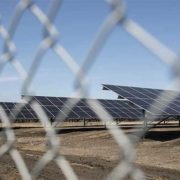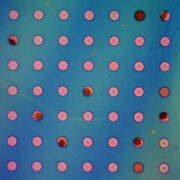Tandem solar cells based on silicon and perovskites have raised high hopes for future high efficiency solar modules. A team led by perovskite solar cell pioneer Henry Snaith at the University of Oxford has now shown, with contributions by Bernd Rech and Lars Korte of the Helmholtz-Zentrum Berlin, that an ultimate efficiency of 30% should be attainable with such tandem cells.
They discovered a structurally stable perovskite composition with its band gap tuned to an optimum value of 1.75 eV. The results have been published in “Science”.
Tandem solar cells based on silicon and perovskites have raised high hopes for future high efficiency solar modules. A tandem solar cell works by absorbing the high energy photons (visible light) in a top cell which generates a high voltage, and the lower energy photons (Infra red) in a rear cell, which generates a lower voltage.
This increases the theoretical maximum efficiency by about 50% in comparison to a standalone silicon cell.
To maximise efficiency, the amount of light absorbed in top cell has to precisely match the light absorbed in the rear cell. However, the band gap of ~1.6eV of the standard perovskite material is too small to fully exploit the efficiency potential of this technology.
A team led by perovskite solar cell pioneer Prof. Henry Snaith FRS at the University of Oxford, in collaboration with silicon solar cell experts Prof. Bernd Rech and Dr. Lars Korte of the Helmholtz-Zentrum Berlin, have shown that an ultimate efficiency of 30% should be attainable with such tandem cells.
They conceived together a tandem cell, in a configuration where the perovskite and the silicon cell are mechanically stacked and contacted separately. The HZB team contributed the silicon cell.
The Oxford group did vary systematically the chemical composition of the perovskite layer, and with a precise cocktail of ions discovered a structurally stable perovsksite with its band gap tuned to an optimum value of 1.75 electron volts, maintaining a high electronic quality of the layer. At the same time, they increased the chemical and thermal stability of the material significantly.
Reference(s):
Publication: D. P. McMeekin, G. Sadoughi, W. Rehman, G. E. Eperon, M. Saliba, M. T. Horantner, A. Haghighirad, N. Sakai, L. Korte, B. Rech, M. B. Johnston, L. M. Herz, H. J. Snaith. A mixed-cation lead mixed-halide perovskite absorber for tandem solar cells. Science, 2016
Story: Optimum band gap for hybrid silicon/perovskite tandem solar cell | Helmholtz-Zentrum Berlin für Materialien und Energie — January 8, 2016











Comments